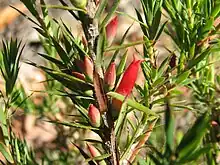Styphelia humifusa
Styphelia humifusa, commonly known as native cranberry or cranberry heath, is a small prostrate shrub or groundcover in the heath family Ericaceae. The species is endemic to south-eastern Australia.
| Styphelia humifusa | |
|---|---|
 | |
.jpg.webp) | |
| Scientific classification | |
| Kingdom: | Plantae |
| Clade: | Tracheophytes |
| Clade: | Angiosperms |
| Clade: | Eudicots |
| Clade: | Asterids |
| Order: | Ericales |
| Family: | Ericaceae |
| Genus: | Styphelia |
| Species: | S. humifusa |
| Binomial name | |
| Styphelia humifusa | |
| Synonyms[1] | |
Description
Styphelia humifusa grows as a spreading mat-like shrub up to 50 cm (20 in) high and 0.5 to 1.5 m (20 in to 5 ft) across.[2] Its hairy stems bear blue-green pine-like acute leaves 0.5-1.2 cm (0.2-0.5 in) long. The tubular flowers are up to 2 cm (0.8 in) long and appear from February to June, and are all red, unlike the red and green flowers of A. pinifolium. Flowers are followed by green globular berries around 0.4-0.6 cm (0.2 in) in diameter, which become reddish as they ripen.[3]
Taxonomy
Styphelia humifusa was first formally described in 1797 by Antonio José Cavanilles who gave it the name Ventenatia humifusa in his Icones et Descriptiones Plantarum.[4][5] In 1805, Christiaan Hendrik Persoon transferred the species to Styphelia as S. humifusa in his book Synopsis plantarum, seu enchiridium botanicum.[1]
Distribution and habitat
The range is in southeastern Australia, from Port Stephens in the north in eastern and central New South Wales, into Victoria, south-eastern South Australia and Tasmania.[3][8][9] It is generally found in open woodland, both on sandstone and clay soils,[3] as well as upland bogs. Associated plant species include Eucalyptus fibrosa, Eucalyptus sideroxylon, and Kunzea ambigua.[10]
Ecology
The eastern bettong (Bettongia gaimardi) eats the fruit.[11]
Uses
Requiring good drainage in the garden, Styphelia humifusa can be grown in rockeries.[12] The juicy berries are edible, although they are mostly made up of a large seed. They can be used to make jams or preserves.[2] The flavour of the berries has been described as "sickly sweet".[6]
The 1889 book 'The Useful Native Plants of Australia records that "The fruits of these dwarf shrubs have a viscid sweetish pulp, with a relatively large stone. The pulp is described by some as being "apple flavoured..."[7]
References
- "Styphelia humifusa". Plants of the World Online. Retrieved 12 September 2023.
- Elliot, Rodger W.; Jones, David L.; Blake, Trevor (1985). Encyclopaedia of Australian Plants Suitable for Cultivation: Vol. 2. Port Melbourne: Lothian Press. p. 248. ISBN 0-85091-143-5.
- Fairley A, Moore P (2000). Native Plants of the Sydney District: An Identification Guide (2nd ed.). Kenthurst, NSW: Kangaroo Press. p. 87. ISBN 0-7318-1031-7.
- "Ventenatia humifusa". APNI. Retrieved 12 September 2023.
- Cavanilles, Antonio J. (1797). Icones et Descriptiones Plantarum. Vol. 4. Madrid. p. 28. Retrieved 12 September 2023.
- Bennett, George (1860). Gatherings of a naturalist in Australasia: being observations principally on the animal and vegetable productions of New South Wales, New Zealand, and some of the austral islands. John Van Voorst. pp. 370.
astroloma humifusum.
- J. H. Maiden (1889). The useful native plants of Australia : Including Tasmania. Turner and Henderson, Sydney. p. 8
- J. M. Powell. "New South Wales Flora Online: Astroloma humifusum". Royal Botanic Gardens & Domain Trust, Sydney, Australia.
- "Astroloma humifusum". Electronic Flora of South Australia Fact Sheet. State Herbarium of South Australia. Retrieved 3 September 2011.
- Benson, Doug; McDougall, Lyn (1995). "Ecology of Sydney Plants 3: families Cabombaceae to Eupomatiaceae" (PDF). Cunninghamia. 4 (2): 217–429. Archived from the original (PDF) on 2016-03-13. Retrieved 2016-05-11.
- Hume, Ian D. (1999). Marsupial nutrition. Cambridge University Press. p. 319. ISBN 9780521595551.
- Gray, Marilyn (2010). "Astroloma humifusum". Archived from the original on 29 March 2011. Retrieved 15 August 2011.